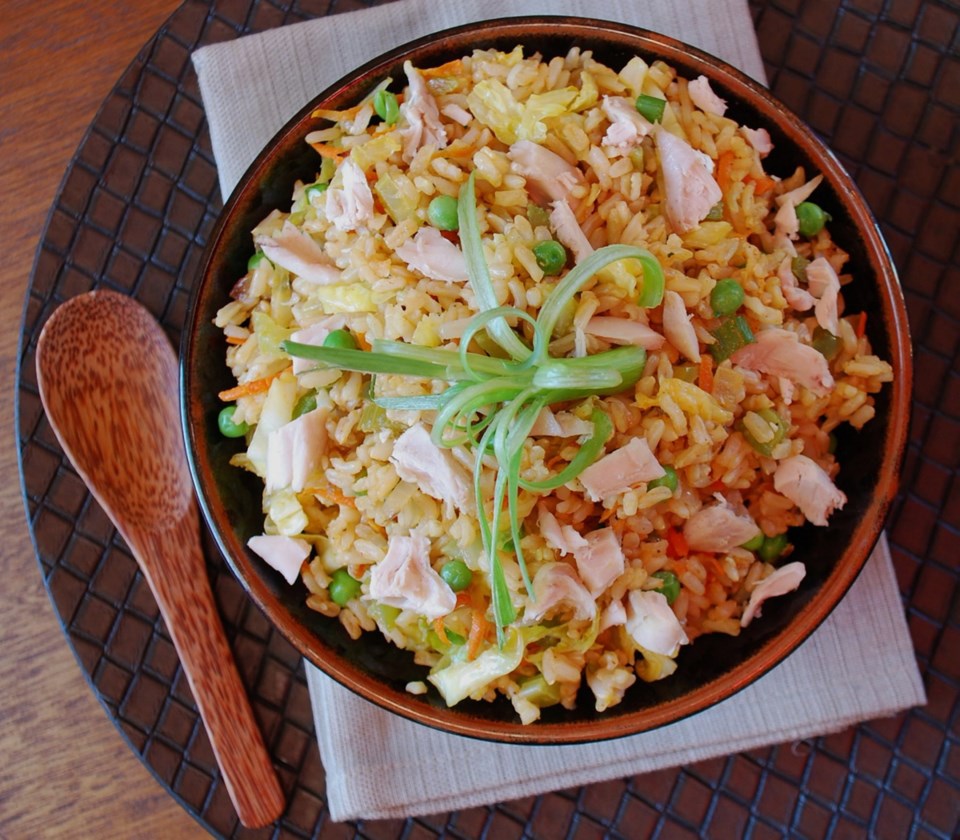 Dear Eric: I am puzzled by the ubiquitous use of white rice when — I believe — brown rice is more nutritious, supplying minerals where the white version does not. Am I correct, and what changes toĚýcooking directions might brown rice require to reach edible status?
Dear Eric: I am puzzled by the ubiquitous use of white rice when — I believe — brown rice is more nutritious, supplying minerals where the white version does not. Am I correct, and what changes toĚýcooking directions might brown rice require to reach edible status?
M. Meagher
Brown rice is the same rice used to make types of white rice, including long-grain, sushi, jasmine and basmati, but the protective bran coating the grain is not removed.
While white rice does offer some nutrition, with that tan-coloured bran layer intact, brown rice is significantly higher in fibre than white rice. It also contains much higher levels of vitamins and minerals, such as vitamins B and E, calcium, protein, thiamine, niacin, riboflavin and iron.
According to Rosie Schwartz’s book The Enlightened Eater’s Whole Foods Guide, another good thing about brown rice is the rice-bran oil and unsaturated fat it contains.
Schwartz says, in brief, that researchers found that rice bran, when tested in people with diabetes, had a heart-healthy effect on cholesterol and triglycerides, and led to better blood-sugar readings.
There are lots of good reasons to eat brown rice, and it is not particularly hard to cook. I steam it in water in a pot on the stove, just as I do white rice. But because the bran is intact, it will take about twice as long to cook as white rice, have a more chewy texture and also have a stronger, almost nutty taste.
Some find the taste and texture of brown rice more than edible, actually enjoyable. But those qualities and a few other facts might also explain why white rice is preferred in Asian countries such as China and Japan, where it has been consumed for centuries.
Removing the bran to make white rice, as noted, speeds up cooking time, important in cultures where a home kitchen might have only one or two burners, and a whole meal is cooked on them.
Removing the bran also creates rice with a more delicate texture once cooked and more pleasing, comforting mouth feel. It also makes it easier to chew and digest the rice.
With the bran gone, white rice also has a milder, less obtrusive flavour. It’s a taste that will work more harmoniously with the items you make or serve, not upstage them, such as sushi topped with almost buttery raw tuna, a delicately flavoured Indian-style curry or a pungent plate of Chinese-style black-bean spare ribs.
Because the oil-rich bran is still intact, brown rice can go rancid more quickly than white rice, which would be a concern in a hot climate. I store brown rice in a tight-sealing container in a cool, dark place or in the refrigerator, and buy only what I can use within a month or two.
In many Asian cultures, diets are made up of lots of vegetables, fruits and seafood, and not a lot ofĚýred meat, another reason white rice can fit into that more balanced way of eating.
I, too, try my best to eat that way. I like both white and brown rice and I see a place for both types in my diet. In today’s fried-rice recipe, designed to use of some of that turkey you might have leftover from Thanksgiving dinner, I opted to use brown rice. IĚýfind the nutty taste works well with the smoky flavour of sizzling hot fried rice.
Ěý
Turkey and Vegetable Fried Brown Rice
It’s best to make fried rice with cold, cooked rice. If you use hot, just-steamed rice, it will overcook when fried. To ensure the grains of rice separate during cooking, let the rice sit at room temperature 20 minutes before frying. Before frying, make sure your pan is very hot, as that will ensure the rice does fry and has a smoky flavour.
Ěý
Preparation: 30 minutes, plus rice chilling time
Cooking time: about 45 minutes
Makes: four to six servings
Ěý
1 1/2 cups long grain brown rice
2 3/4 cups water
2 Tbsp vegetable oil
1/2 medium onion, finely chopped
1/2 medium green bell pepper, finely chopped
1 large celery stalk, finely chopped
1 cup thinly sliced Chinese or green cabbage
1 large garlic clove, minced
2 tsp chopped fresh ginger
1 cup diced turkey meat
1/2 cup frozen peas
2 green onions, thinly sliced
2 Tbsp light soy sauce
• freshly ground black pepper to taste
Ěý
Place brown rice and water in a medium pot (mine was six inches wide), set over high heat and bring to a rapid boil. Cover the rice, reduce the heat to its lowest setting, and cook, undisturbed, forĚý35 minutes, or until the rice isĚýtender.
Spread rice on a baking sheet, cool to room temperature, and then refrigerate a few hours or overnight, until well chilled.
When ready to make the fried rice, let the rice warm at room temperature 20 minutes,
When all your other ingredients are prepared and ready to cook, heat the vegetable oil in a wok or a very large skillet set over medium-high.
When the oil is very hot, add the onions, bell peppers, celery, carrots, garlic and ginger, and stir-fry until the vegetables areĚýjust tender, three to four minutes.
Add the turkey and rice and stir-fry for two to three minutes more. Stir in the peas and green onions, season with soy sauce and pepper, and cook for one to two minutes more, or until rice is piping hot.
Eric Akis is the author of eight cookbooks. His latest is The GreatĚýRotisserie Chicken Cookbook (Appetite by Random House). HisĚýcolumns appear inĚýthe Life section Wednesday andĚýSunday.



